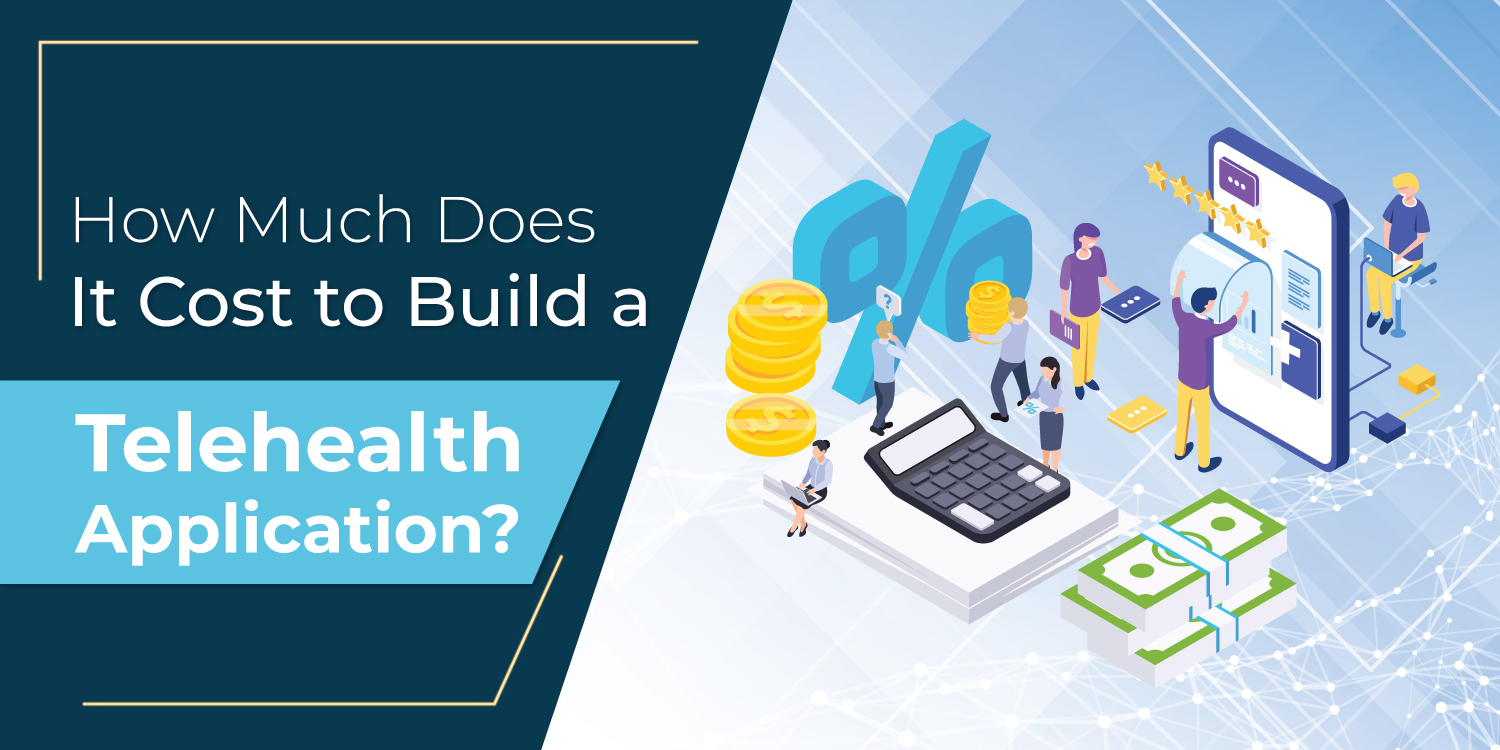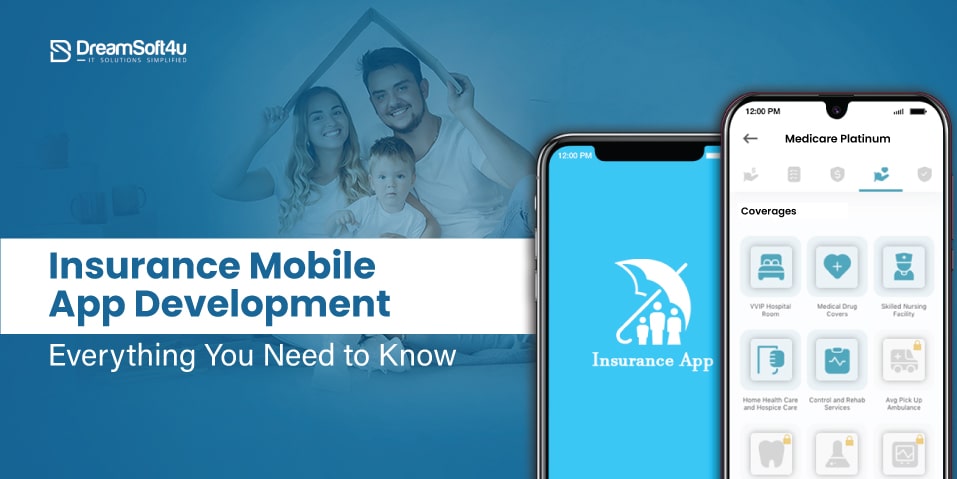The COVID-19 pandemic had a significant influence on digital health. It has drastically improved the use of telehealth applications among the masses as people prefer to get medical assistance online irrespective of visiting doctors at their clinics or hospitals. As a result, healthcare organizations are making their way toward telemedicine app development to offer patients healthcare services from a distance.
According to the Statista report, the global telemedicine market will reach $559.52 billion by 2027, which showcases that the healthcare sector will inevitably go online. But what benefits will telemedicine bring to businesses?
Telemedicine is a platform that brings doctors and patients together for a simplified consultation process and always keeps them in touch. Other than this, doctors who provide healthcare services to patients privately would not need to rent working space, while hospitals would register a reduction in readmission rates. The telehealth application is a new powerful channel for both the service providers to convey their services to the needy ones.
In this blog, you will get to know the important aspects of telemedicine app development, including its features, costs, development process, and other key elements.
Table of Contents
ToggleMust-have Features of Telemedicine Mobile Apps
When you partner with an industry-leading telemedicine app development company like DreamSoft4u to build your telemedicine application, you will be provided with a set of common and must-have features for almost every telehealth application that caters to three groups of users. You can even ask for the development of specific features depending on your healthcare business needs. Let’s shed some light on the must-have features of telehealth applications.
1. Patient Panel Module
This module is dedicated to serving the end-users of the application patients. Therefore, it should include an uncomplicated, straightforward, easy-to-use set of features. The list of crucial features for the convenience of the patients is mentioned below.
Sign Up/Sign In
It enables patients to register/sign up for the application, following the minimum steps to use various features at their convenience.
Call and Chat Option
The patient panel module should incorporate an uninterruptible mode of communication, either for call or chat, to provide doctors and patients a platform to connect easily for required consultation and diagnosis.
Finding A Doctor/Clinic and Booking An Appointment
Using this feature, patients can locate a doctor or clinic in their area and book their appointments online.
Clinical Records
It enables patients to safely store and update medical information like prescriptions, medications, allergies, surgeries, etc.
Online Payments
There should be online payment ease through different payment gateways in demand.
Reviews and Ratings
This feature enables patients to share their views regarding their visit to the doctor and offer treatment.
2. Doctor Panel Module
Dedicated to the service providers, this module should be packed with the features needed to provide hassle-free services to the patients. It would include features that help doctors interact with the patients easily either via video call or chat so that they can provide their services remotely.
Managing Profiles
This feature enables doctors to include their basic information like name, address, photograph, specialty, and availability. Also, it gives ease of editing the profile whenever needed.
Appointment Management
This feature allows patients to schedule an appointment through the app once they have located the appropriate medical provider. Besides, they can provide information about their health conditions and medical history. Even the time slot should be managed automatically and show whether one expert or another is open.
Patient Records And Medical History
The telemedicine software should be competent to store, and maintain data, and keep a log of the patient-doctor interaction. That is possible only when the app has clinic management software because it serves as a base that stores patient records and their medical history.
Digital Prescriptions
With the telehealth application, healthcare providers should be able to administer prescriptions directly. Patients may use these prescriptions to purchase medication or get other medical care at medical facilities.
3. Admin Panel Module
The admin module can be understood as a connector between the service seekers and the service providers. This panel manages the important tasks of keeping track of all activities, storing user data, performing analysis, and generating reports. Besides, it also manages patient and doctor records, including financial and other information.
Other than this, it ensures data security for the patients complying with the mandatory regulations. Incorporating all of the above functions constitutes an admin panel for smooth and consistent functionality.
- Admin/User Dashboard
- Appointment Management
- Notification Management
- Transaction Management
- Reviews & Ratings
Technologies Behind Telemedicine Apps
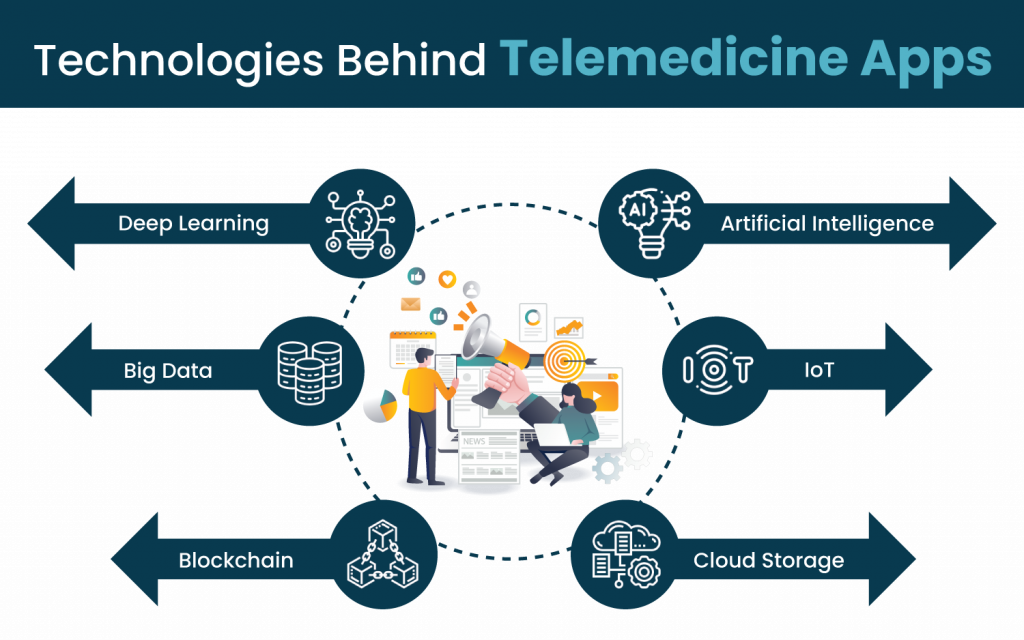
A telemedicine app can have plenty of features to develop. But what technologies will be used, and how can you stand out for your app? It includes implementing ongoing healthcare technology trends, including artificial intelligence, the Internet of things, cloud technologies, etc., with telehealth application development. Let’s discuss these healthcare technology trends in brief.
Artificial Intelligence:
A great example of an Artificial Intelligence use case is chatbots. It is understood that doctors can’t be available all the time. Therefore, chatbots are better replacements to answer users’ questions about the doctor’s schedule, competency, etc. Chatbots can even reverse a consultation if a patient doesn’t have any specific requests. But chatbots also have limitations as they can’t prescribe medicines or set up a treatment plan, they can only automate some routine processes to save doctors valuable time.
IoT:
The Internet of Things is also a monster name among healthcare technologies. IoT-based wearables let doctors monitor patients’ conditions and receive notifications in case of emergency. Gadgets like fitness trackers, stress meters, scales, and others let doctors collect patients’ health statistics and adjust the treatment plan accordingly. With Smart drug dispensers, physicians can set a pill schedule without involving patients. A dispenser then will send notifications to the user’s phone when it’s time to take pills.
Cloud Storage:
You have only two options when storing all gathered data, either cloud or on-premise. With an on-premise model, you’ll have to invest a hefty amount in renting a place for servers, buying the hardware, and building a fault-tolerant network. Then you will be able to get the storage that you can manipulate and scale as per your requirements. And the expense to maintain the whole system is way costlier than the cloud storage.
If you go with cloud storage, for example, S3, you will be charged $0,022 per month for a gigabyte of space. However, the price majorly depends on the region and the amount of space you need; still, it will cost you significantly less than if you go for an on-premise model. Also, you will benefit from a ready-made security system from Amazon that reduces development costs.
Blockchain:
Blockchain technology allows data sharing among doctors and patients in a secure encrypted format. The technology sees a higher rate of adoption in healthcare to offer a secure data transfer ease in telehealth applications. Using its distributed networks, healthcare professionals can seamlessly share patient information.
Big Data:
As everyone knows healthcare organizations deal with a large amount of data from generation to its processing. Big data enables them to collect and analyze EHRs (electronic health records). Using this information, they can provide better care to patients, deliver a more accurate diagnosis, conduct medical research, and reduce healthcare costs. In addition to this, big data analytics techniques can be used to prepare a proper dose of medicines and treatment plans for individuals in remote areas.
Deep Learning:
Integrating deep learning into the telemedicine app helps obtain insights from vast amounts of medical data. Using this technology, healthcare service providers can make more accurate predictions about a patient’s well-being.
Tech Stack for Telemedicine App Development
After knowing about the technologies behind telemedicine apps, it’s time to focus on tools, programming languages, and other aspects used during telehealth application development.
Programming languages:
- Swift (iOS)
- Java, Kotlin (Android)
Back-end development:
- Programming language: Node.js
- Database: MySQL
- APIs and frameworks: Stripe, S3, EC2
- Videoconferencing: WebRTC, RTMP, Twilio
- Chat: Twilio, Socket.io
Tools:
- Mailing: Elastic Emails
- Search & filters: Elastic search
- Geolocation: Google Maps Platform
- Notifications: Firebase Cloud Messaging
Benefits of Telemedicine Apps
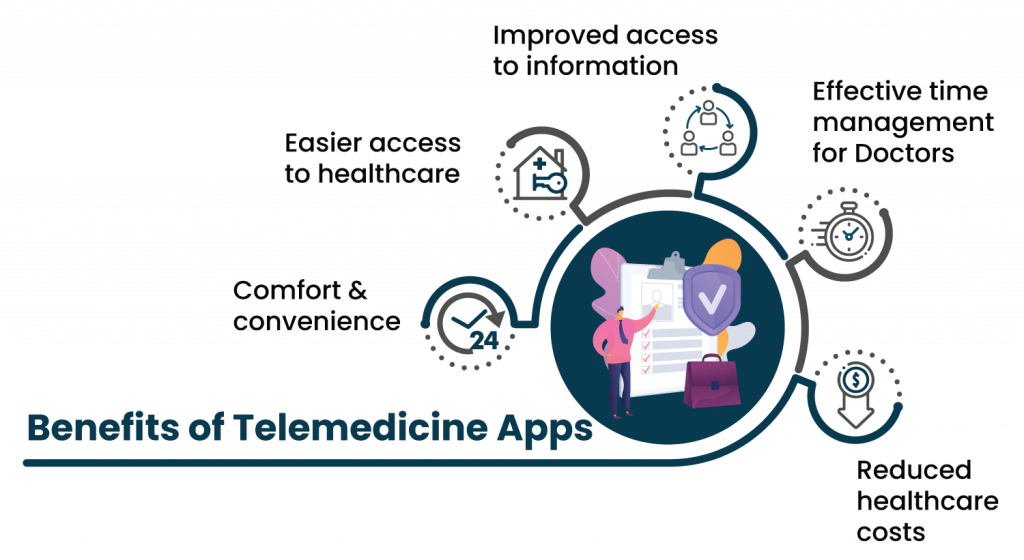
Let’s look at the top benefits of telemedicine apps and how they could transform your healthcare business in the coming years.
Comfort and Convenience
With telemedicine apps, patients don’t need to travel to hospitals or stand in a long queue for their turn when they are sick. They can consult with their doctor concerning illness or disease from the comfort of their home through video conferring. Also, it refrains them from taking time off from work or arranging childcare, resulting in time and money saving.
Easier Access to Healthcare
Telemedicine apps allow patients in rural or remote areas to access a specialist. Even doctors can refer patients to the specific specialists they need, irrespective of their location. In the United States, there are only 43 specialists for every 100,000 rural patients.
Improved Access to Information
Telemedicine apps provide doctors with access to patients’ histories. That includes information about diseases, provided treatment, and the effect of particular treatments. Following this, doctors can make better decisions.
Effective Time Management for Doctors
Virtual consultation through telemedicine apps enables doctors to better manage their time by streamlining patients’ appointments.
Reduced Healthcare Costs
Online visits through telehealth applications reduce healthcare costs to a greater extent. According to a study, the average maintenance cost is reduced by 94% with reduced outpatient visits.
This cost includes the traveling cost of home-bound patients via ambulances and clinic support/front desk staff.
How Much Does It Cost to Develop an MVP of a Telemedicine App?
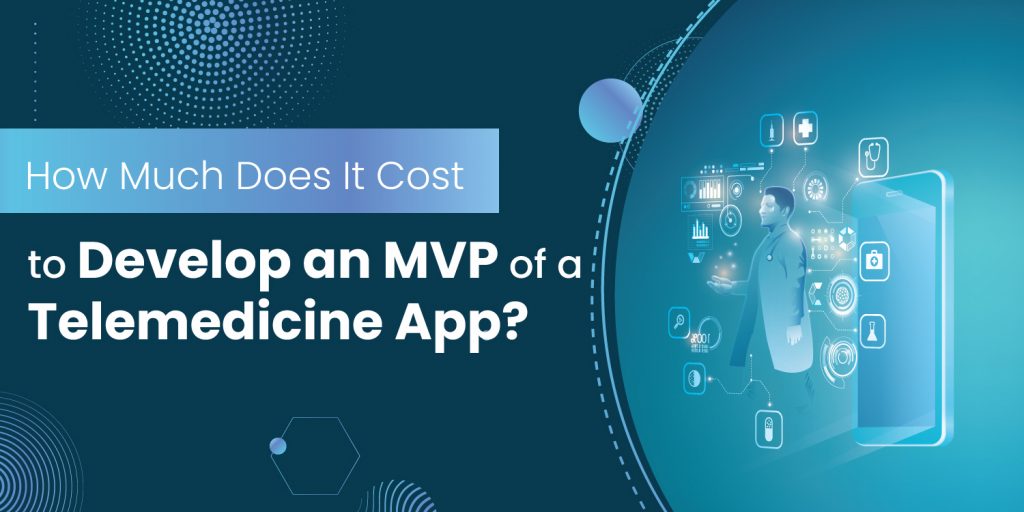
An MVP of the app is a working prototype that is test-ready. Its development stage includes a ready-to-implement design, key features, software architecture, and an app that real users can test.
Now, look into the time consumed in developing an MVP of a telemedicine app.
An MVP development usually takes up to six weeks and costs around $15,000.
Once MVP has been tested, it’s time to upgrade it into a full-fledged app. However, telemedicine app development cost depends entirely on the following aspects.
- App versions: doctor, patient, hospital, admin, etc.
- Deployment platform: mobile, desktop, both.
- Incorporated Technologies, Blockchain, IoT, etc.
- The complexity of the app’s features
- The complexity of the design
- The location of the development company
A basic version of the telemedicine app that incorporates a simple app design, no technology integration, mobile deployment, and basic three versions patient panel, a doctor panel, and an admin panel will cost you anywhere from $50,000 to $80,000.
If you want to build a feature-loaded, complex app incorporating technologies, and multiple features, the development will be around $150,000- 250,000. At the same time, it will consume an average time of 3 to 12 months. You can contact us to consult your telemedicine project.
Have An Idea For Telemedicine?
We Build Telemedicine App! Get The FREE Estimation Of Your Product Idea.
Talk to usHow to Monetize a Telemedicine App?
There are many ways to monetize a telemedicine app. However, the most prevalent way is fees. For instance, you can consider a Doctor on-Demand app that charges 25% fees from patients to use app features like doctor consultation. You can also include a fee element in your application.
Other than this, the membership model is also used by several apps wherein patients buy a monthly subscription to access app features at discounted rates. The third and last one is providing your product as a software-as-a-service wherein organizations get connected with you to offer healthcare ease and services to their employees.
Final Words
With this, we have covered all the essential aspects associated with the telemedicine app development cost. Still, if you think any of your questions are not answered here. You can contact our health experts as they feel pleasure in helping businesses bring their telemedicine app idea into reality.
FAQs
Q1. What are the factors that impact the cost of developing a telehealth application?
A telehealth application must comply with regulatory requirements such as HIPAA and GDPR. Other than this, factors like features, the development platform, and the level of integration with other systems are equally important.
Q2. How much does it typically cost to develop a telehealth application?
The cost of developing a telehealth application can vary widely depending on the above factors. Typically, it can cost anywhere from $50,000 to $500,000 or more.
Q3. What are some cost-saving strategies during the development process?
Ideally, our team suggests open-source tools and frameworks, leveraging pre-built libraries, and prioritizing essential features over non-essential ones.
Q4. Are there any ongoing costs associated with application maintenance and updates?
Yes, there are ongoing costs associated with maintaining and updating a telehealth application, such as server hosting, security updates, and feature enhancements.
Q5. How can I get the best value for my investment in developing a telehealth app?
It is always wise to work with an experienced development team. At DreamSoft4u, we have experienced healthcare IT developers that with a proven track record of delivering high-quality solutions within client budgets.

